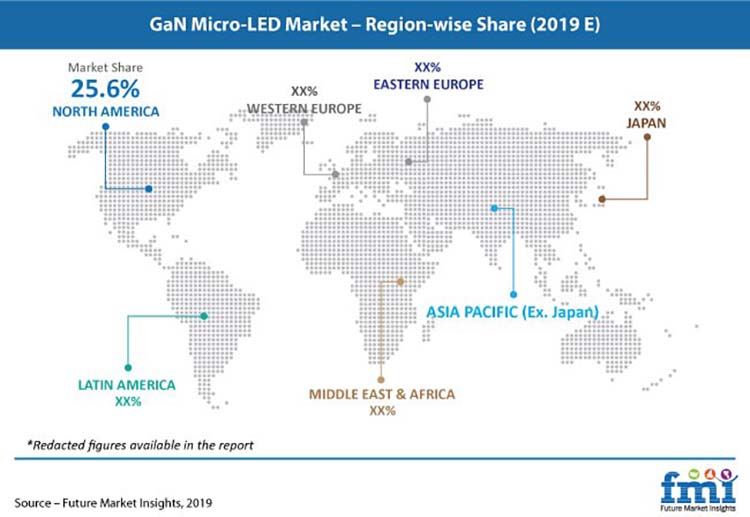Future Market Insights (FMI), in its new study, has predicted the worldwide sales of GaN micro-LED will increase 33% year-over-year to reach $197,000 in 2019, up from US$ 150,000 in 2018. GaN micro-LED has been in the research laboratories for years, and the launch of Samsung’s Micro-LED displays, featuring self-emissive technology and modular capabilities, left consumers curious about the emerging technology.
FMI report expects that GaN micro-LED will soon be a mass market proposition, as an array of millions of microscopic LEDs is set to replace incumbent technologies such as LCDs and OLEDs and penetrate major digital displays markets.
Despite their extremely high price tag and significant complexity in design, GaN micro LEDs are gradually finding acceptance in a wide range of applications, in the view of greater efficiency, improved brightness, and lower power consumption. As the war of innovation supremacy continues in the display markets, GaN micro-LED market players are putting greater emphasis on bringing the production challenges under control and costs down.
FMI’s analysis projects the sales of GaN micro-LED to ramp up at an impressive CAGR of 43.5% during the period, 2019 to 2029, as the technology promises to offer better and brighter displays as well as lighting than the current solutions. Sensing the application potential of GaN micro-LED in newer models of TVs, smartwatches, AR devices, and head-mounted systems such as Google Glass, stakeholders are making rigorous investments in R&D and deepening their collaborations with technology solution providers.
Mid Power Micro-LEDs for Lighting Applications to Capture Robust Share
As indicated by the study, the consumption of mid-power GaN micro-LEDs, which accounted for 75% share in 2018, will become a mainstream for lighting applications in the years ahead. However, significantly large percentage of the cost of mid power micro-LEDs goes to packaging, thereby limiting the advantage of lowering its overall costs.
On the hand, demand for low power micro-LEDs is likely to garner significant traction in the future, in the view of maintaining full brightness without the loss of noticeable display brightness over the entire illumination time.
Greater demand for GaN micro-LED displays will continue to influence the growth strategies, accounting for 79% share in 2018. As identified by the FMI analyst, gains will remain driven by growing demand for visual aspects in modern-day devices, increasing need for high luminance in small format for near-to-eye display devices, and the demand for high resolution and efficient luminance in battery-powered consumer electronics.
Market Gains Underpinned by Greater Innovations in Sports & Entertainment Space
In recent years, high application potential of GaN micro-LEDs has been identified sports & entertainment space, on the account of a spike in number of video-streaming services, rapid innovation in television to enhance the viewing experience, and increased penetration of new-generation video-gaming products and accessories, says the report.
While consumer electronics are likely to account for major share of the manufacturers’ bottom lines, capitalizing on ever-expanding sports and entertainment space will remain a key focus area of the market players. On the one hand, consumption of GaN micro-LEDs by the automotive industry will increase 39% y-o-y in 2019, backed by the emergence of ‘in-car ambience’ and ‘auto-infotainment’ trends leading to innovations in automotive displays units as well as interior automotive lighting.
North America in the Vanguard
Accounting for 26% share in 2018, North America is anticipated to remain at the forefront of GaN micro-LED market. According to the study, European market is likely to lose its second position to Asia Pacific in the foreseeable future, as many players in the latter region are constantly demonstrating their progress and latest breakthroughs in the GaN micro-LED technology.
Unprecedented evolution in number of industry verticals has pushed stakeholders to redefine their growth strategies to retain and attract new segment of customers. In addition to focusing entirely on the new technology while ceasing the launch of conventional solutions, stakeholders are centered on collaborating with research institutes to synchronize their advances.


